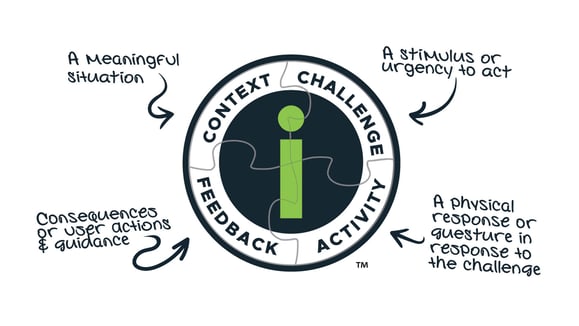Now that we understand the need for 508(c) compliant e-learning, you might be wondering, “How do I transform my existing learning or create new training that’s compliant without boring my learners?”. I’m glad you asked because it’s something that I’ve been giving a great deal of thought to.
How will my e-learning change with 508 compliance?
At face value, full adherence to the guidelines nudges the author of a piece toward linear, text-centric presentations where the interactivity is focused primarily on navigation. This may be an adequate model for informational web pages, but it is, unfortunately, also an accurate characterization of ineffective e-learning.
If you haven’t been held to 508 guidelines previously, some of the ways that your learning may need to change include:
- Text Transcripts: 508 compliance presentations reduce content to text transcripts for audio and video tracks for learners with hearing impairments.
- Alt-Text: Automated screen readers can make printed text and image descriptions available to learners with vision impairments. This means the message must be clearly summarized in a readable linear transcript and alt tags.
- Navigation Gestures: Accommodations for mobility impairments often disqualify drag-and-drop interactions, and to a lesser extent Hot Spot and Hot Object formats, and instead make use of standard button-based question formats for simplistic responses and navigation gestures.
Now it's compliant - but is it CCAF?
CCAF design is the approach to designing instructional interactivity introduced by Michael W. Allen which requires instructional interactivity to include meaningful Context, engaging Challenges, specific related Activities, and content-rich corrective Feedback. Where 508 compliant media is streamlined to be universal for a wide range of learners, CCAF aims to:
- Avoid excessive use of text
- Build relevance with visual and audio cues to suggest a real-world environment
- Engage with simulated gestures coordinating visual and spatial actions made possible with mouse-based interactivity
- Invite adaptive experiences based on learner-driven branching
- Use multi-media effects to provide intrinsic Feedback
CCAF stipulates that an engaging and effective instructional interaction integrates these 4 elements:
- Context
Context provides meaning and relevance. It communicates to the learner that the skills and knowledge have meaning and usefulness in the real world. - Challenge
Challenge is used to engage the learners’ emotions, motivating them to engage authentically and with intention. Challenge is created through risk, meaningful consequences, and achievable goals. - Activity
Activity refers to the gestures required of the learner. Gestures should evoke knowledge and actions that exist in the performance environment and can be applied beyond the e-learning course. - Feedback
Feedback is how the learner responds and adapts to learner actions—where learning outcomes are validated and reinforced. Feedback indicates correctness but also communicates how the learner can improve.
Does compliance mean that my e-learning has to be boring?
Short answer: no—but you do need to be aware of the changes needed to create inclusive learning. Section 508 guidelines are directed toward all IT and electronic documents, not specifically for e-learning. Under that lens, the regulations approach the problem chiefly from an information presentation perspective rather than an interactive perspective.
“But that's impossible!"
I find that the immediate and near-universal response to advocating for elevated instructional design in e-learning is “That can’t be made 508 compliant.” In most cases, that statement only sounds reasonable if one neither understands Section 508 requirements nor understands CCAF Design, as good instruction is certainly achievable with smart adjustments and considering the learner instead of slavishly adhering to a rule.
Final thoughts
With 508 compliance guidelines, there are certainly challenges that present themselves when creating Meaningful, Memorable, and Motivational e-learning that incorporates CCAF design elements. With creativity and consideration of the most important aspects of learning, we can work towards combining these guidelines for training that is not only effective but also engaging and inclusive.
-1.png?width=75&height=75&name=Copy%20of%20It%20is%20not%20the%20strongest%20of%20the%20species%20that%20survive%2c%20nor%20the%20most%20intelligent%2c%20but%20the%20one%20most%20responsive%20to%20change%E2%80%99%20(11)-1.png)








Comment